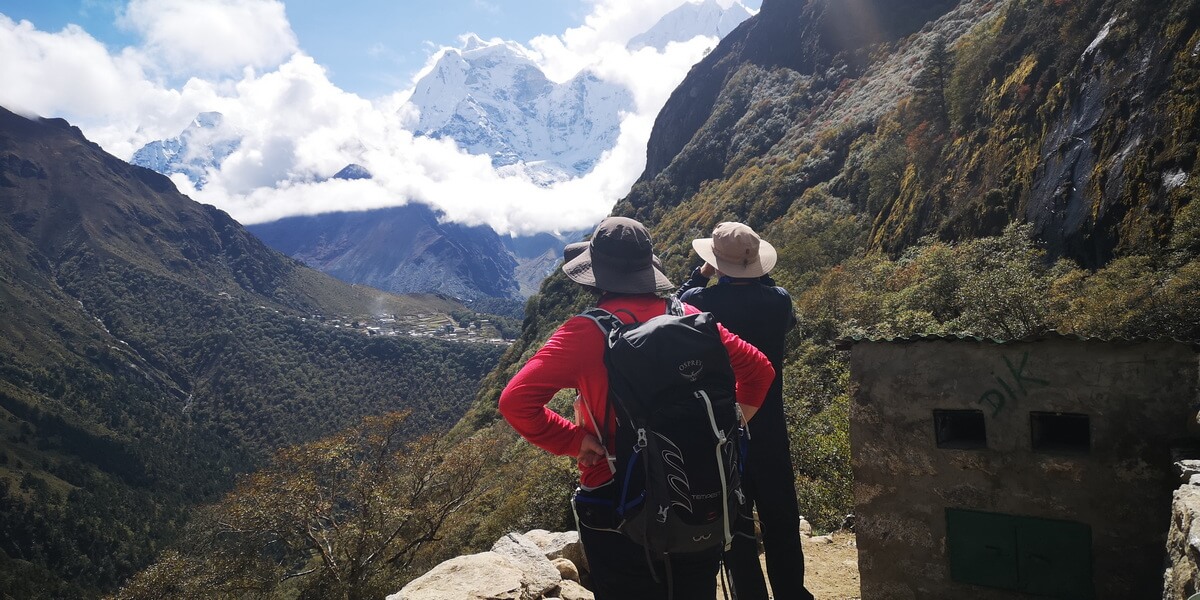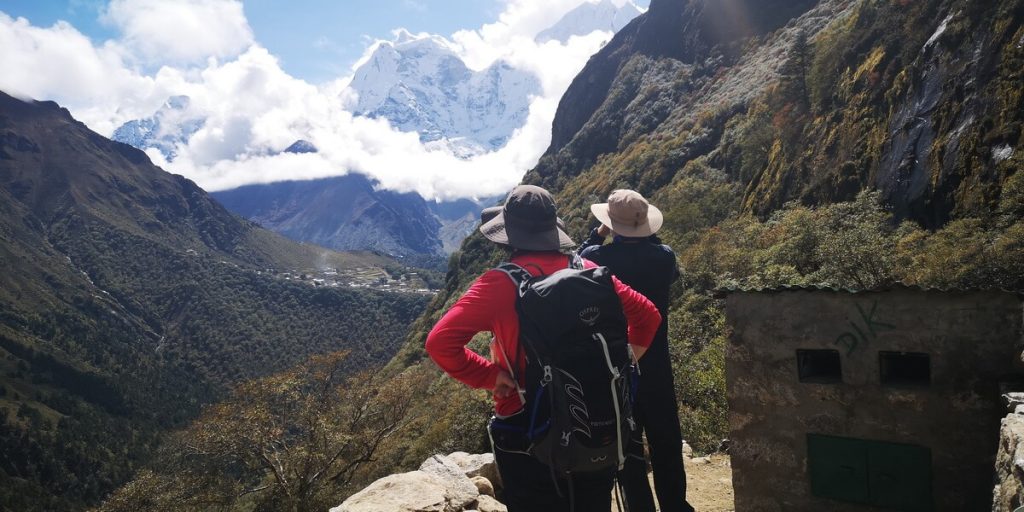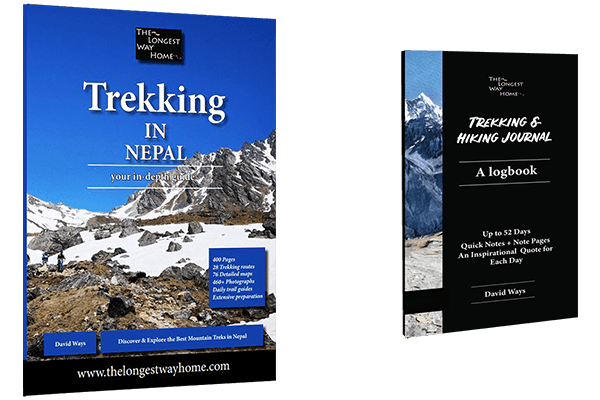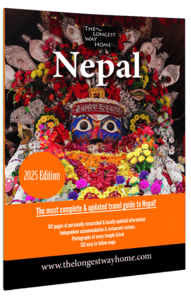

Update on the compulsory trekking guide rule in Nepal
If you are just discovering about the new mandatory trekking rule in Nepal, then please read my no holds barred article on the ban on independent trekking in Nepal for all the reasons on why it happened, where it’s being implemented, and what to do about it.
This page contains the very latest information on the ban on solo trekking based on my own boots on the ground experience, plus insider information on what TAAN (Trekking Agency Association of Nepal) and NTB (Nepal Tourism Board)have actually done since March and what you as a trekker can expect for the rest of the year in Nepal.
Hopefully it can help people wanting to know more about the situation as it is now and for those who are making up their minds about coming to Nepal for trekking.
Did the ban on Solo Trekking go ahead this year?
Yes, beyond a shadow of a doubt both TAAN and NTB have categorically stated that all non-Nepali trekkers visiting Nepal for trekking must have a registered trekking guide. They have removed all TIMS Cards for sale to independent trekkers and now only allow registered trekking agencies to issue them. There was also a fine introduced of USD $120 for any trekker caught without a guide. Trekking agencies are also being fined for issuing TIMS cards with no guide.

TAAN started the ban by giving out daily statistics on the number of TIMS cards agencies were selling. This all stopped after 4 weeks. Meanwhile the Solukhumbu region (Everest treks) refused to comply with the directive and they still to this day allow trekkers without a guide to trek in their region. No official statement from the Ministry of Tourism (above NTB) was published. Despite promises, TAAN did not open a single TIMS checkpoint to check TIMS cards or trekkers. No solo / independent trekkers were stopped. Police checkpoints let all trekkers with or without a guide through with no fine or harassment.
So the reality is the ban is in place, with warnings being published by TAAN and NTB, but there are no checkpoints or any staff manning the checkpoints.
Why did TAAN not put staff in the checkpoints?

That’s the big question. Again, do read my article on solo trekking being banned in Nepal for an in-depth look at the real reasons for the ban. In summary, when the ban was introduced they said checkpoints would be manned by April 1st. It never happened. I know people who work there. They said management were trying to recruit staff on low salaries and nobody was interested. The officials just kept saying, next week they will be staffed. Followed by next week, And, next week. It never happened.
Up until now, there has been no training, or recruitment drives for staff to work at the checkpoints.
So, again, as I wrote back in March as the ban was being announced both TAAN and NTB were and are simply pulling a massive money grab. There’s been zero new facilities, sign posts, training, or work put into trekker safety before, during, or after the announcement despite the massive amount of money they made from TIMS cards sold since the ban on solo trekking.
Meanwhile, this month TAAN announced new minimum guide salaries of $31 per day. And new porter minimum salaries of $24 per day. Moreover, on the 16th of July there might be a 13% TAX on domestic flights including to Lukla. Couple that with the international cost of living increases and the cost of trekking in Nepal is rapidly increasing. A return flight to Lukla could soon cost $400. That’s more than a return flight from Kathmandu to Kuala Lumpur!
Did the ban reduce the amount of trekkers visiting Nepal?
No. The reason for this is simple. The ban became official on April 1st, which was too late for most first peak season of the year trekkers to cancel international flights or indeed trek bookings. So for that very reason numbers were not reduced. However, the number of guides hired increased greatly as trekkers were caught unaware and struggled to find reasonably priced guides on short notice.

A side effect of the above is that price gouging became rampant. Trekking companies were doubling their guide fees as trekking guides became short in supply. Then came the reports of trekking agents adding on fees for permits and claiming it was a new tax (there was no tax). $30 National Park Fees became $50 as did TIMS cards. Thankfully trekkers who did their research were aware of this scam, but those that didn’t ended up paying.
The real answer to if the trekking ban reduced tourist numbers won’t happen until this coming season in 2023 and indeed in 2024 as many people are still unaware of the ban on independent trekking.
Did banning solo trekking reduce trekker deaths?
That’s another question that is difficult to answer. Numerous unsubstantiated reports of missing trekkers circulated this year in Solukhumbu (the region that allowed solo trekkers), however not one was substantiated. This is the first year these “reports” appeared in the manner that they did. Via guides, trekking agents, and social media. Again, none of them were ever proved.

One man who died of natural causes in the Solukhumbu region (who allow solo trekking) was photographed and the image was circulated repeatedly by guides, and trekking agents touting that solo trekking was dangerous. Again, he died of natural causes. There certainly was a pro-mandatory guide group pushing the agenda at any cost across social media. Strangely guides, and porters who died so far this year did not get as much publicity. Neither did the lack of weather warning systems during a late snow storm.
It won’t be fully known if trekker deaths or missing trekkers have been reduced until the end of 2023. The main peak season of the year is yet to start (when most people come). At the end of this peak season we should know if A) trekker numbers have risen or fallen, and B) have there been less deaths and missing trekkers.
So, the big question: Do you need a mandatory trekking guide this year in Nepal?
Firstly, I have always advocated that first time trekkers should take a guide when trekking in Nepal. I’ve seen six foot five military guys with experience trekking elsewhere fall to their knees trekking in Nepal despite being warned. From air quality, to food, terrain, weather, and so forth Nepali mountain trekking should be treated differently than elsewhere. If you have experience trekking specifically in Nepal, then trekking alone is a choice you should be able to make for yourself.
For now, you 100% do not need a trekking guide for any trek in the Solukhumbu treks. That’s treks like EBC, Three Passes, and Gokyo.
Officially, for all other treks that require a TIMS card then yes you need a mandatory guide. However, there are no TAAN or TIMS checkpoints open anywhere. So nobody is checking. The police will likely ask you if you have a guide or not. If not, they’ll just let you pass.

Does this mean you can go without a guide or TIMS card? It means legally no, but the reality is people are going trekking without the implemented checkpoints being open. This could all change within the space of a couple of weeks (will update here). TAAN could send a bunch of new guide out to staff the checkpoints, but all indications are that they are not doing this at the moment.
Again, in all cases, my take is if you haven’t trekked in Nepal before, hire a guide.
Full trekking details are in my books below ( the only guidebooks that include entry fees) and indeed if you are looking for a local registered guide then you can also use my Find a Trekking Guide Service.
Get my Trekking in Nepal Guidebook & discover more than anyone else!
Looking for more insider tips and information like this? Get the most up-to-date, popular and dedicated guidebook to Trekking in Nepal in the world. Covering 28 full treks over 400 pages. The only trekking guidebook in the world with trekking links showing you how to link treks together! Available as an instant download or worldwide shipping for the paperback edition!
Take a look below and you’ll find out why this beats all other guidebooks!

Get the Digital Trekking in Nepal guidebook here!
Get the Paperback Trekking in Nepal Guidebook here!
Get the paperback Trekking & Hiking Journal here!
Looking for the whole country or the most popular treks? Get my full Nepal Guidebook (the only guidebook in the world today that includes entry prices for everything, full maps, and of course the best information).


Wow, what an incredibly informative article! I want to express my heartfelt appreciation for providing the latest information on the mandatory trekking guide rule in Nepal Your dedication to sharing accurate and up-to-date information is commendable. We’ll be visiting this year and taking a guide just because we want to enjoy Nepal more and learn about it from them. Thanks for all the help you offer!
No problem and thanks for the kind words. I hope you have a great trek.
I’m amazed that Nepal continues to enforce this rule. Like you wrote, let’s see how many tourists opt not to visit this coming season due to the rule. Then we might see a change.
Yes, many people looking at the long-term are hoping numbers are down this year to prove that this “rule” is a bad idea.
Thank you for providing an update on this. There is so much confusion out there. We were quoted $150 for two permits due to new regulations. Even the Annapurna Park website said it was $30. Then we found out the other TIMS permit was $20. Which means it was $50 each, okay. So we emailed the trekking agency and they replied the other $50 was an additional charge they offer to get the permits.
We bought your guidebook and knew that what they said was not true so we skipped them and went with one of your recommendations!
So many people trying to skim a little off the top. I could just imagine what they would have done in person. Thanks for giving us the real truth in costs! It helped a lot
Unfortunately it looks like you got one of those rogue trekking agencies who were adding on a commision for getting permits. There’s no commision on permits in Nepal other than the “restricted permits” like Upper Mustang which they might charge for as it involves a trip to the immigration office. Otherwise most trekking companies simply get the National Park permits enroute and the TIMS card online. Glad you got the right information from the guidebook! Thanks for the purchase.
Always good information here. As you say, you witness this day to day which makes all the difference.
Yes, boots on the ground helps Anna!
If only they would get this sorted out, we would visit Nepal. The fact that it would cost us nearly $120 per day for our trek, with the added international flights, plus uncertainty in Nepal means we are changing our holiday to Romania. Europe is cheaper than Nepal! Imagine that in this day and age!
It’s difficult to say what your daily rate is without knowing the details of how many people, which trek, what time of year etc. The cost of living increase across all countries has also affected Nepal. But not as much. For one person $120 certainly sounds high. There’s a breakdown in prices in my Trekking in Nepal Guidebook which helps you calculate the daily cost.
I didn’t know they rose the cost of guide to $31 per day! I know that compared to other salaries it is very low, but then so is their cost of living. It’s the huge jump in cost I don’t understand, so random. Is this now the official rate of hiring a guide in Nepal?
$31 is the new official rate set by TAAN in July 2023. However, it’s not enforced and nobody will pay any attention to it as trekking agents tend to outbid each other depending on the time of year.
The cost of a flight to Lukla is insane! And they are increasing it?! Why is it so high compared to intentional and other domestic fares?
Yes I fully agree that Lukla bound flights are too expensive. If there is an added 13% tax this year it will go up again. It’s also a two-tier price as Nepali and Indians get a much lower fare. It was also stopped 3 years ago with near equal prices, but since then they’ve increased the non-Nepali price considerably. It may also be linked to the Everest Region rejecting the mandatory trekking guide rule and “some” people in charge trying to discourage trekkers from that area. It’s not really working if that’s the case.
So, they made this rule, but never implemented it? Is that correct? Does this mean we can visit and do Annapurna Base Camp without a guide? (We’ve done two other treks in Nepal and have enough experience, it’s only this new rule that’s putting us off. We just want the mountains to ourselves)
Yes, that is correct. So far this year there have been no open checkpoints on any trek with TIMS cards required. It might all change, but for now it’s typical of Nepal to make a rule and never enforce it.
I’ll be returning to Nepal for the 5th time later this year. I really appreciate the effort you put in keeping us updated on all this. I bought your trekking book and it blew me away. Great stuff there.
We’ll take it as we find it when we arrive. It’s typical Nepal to make a rule and then never go through with it! Just like the car honking ban. Honk Honk everywhere.
Ha, yes it’s the same old antics in the country. This year NTB joined the chaos and really made it confusing for people. Hopefully this whole mandatory guide thing will fade away. Glad you found my guidebook good! Have great trek!
Just to say thank you for the update Dave, are you in Nepal at the moment?
Thanks Paul, trekking at the moment!
I was unaware that the price of a guide had increased to $31 per day.
Yes it increased this year. It’s official.
This update further cements the controversial decision to ban solo trekking in Nepal, a move that has drawn criticism for being more of a revenue-generation strategy than a genuine effort to improve trekker safety. While the increased guide and porter salaries are a positive step, the potential additional tax on domestic flights and the rising cost of living could make trekking in Nepal prohibitively expensive for many. It’s concerning to see the escalating costs with no tangible improvements in safety measures or facilities for trekkers. It’s crucial for the authorities to transparently address how the revenue generated is being utilized to enhance the trekking experience and safety in Nepal.
Yes I would agree that Nepal needs to step up it’s flight safety and indeed give a better return on tourists money spent. The current focus on high-end tourism is simply not sustainable. Catering to all budgets would be a better approach. Not to mention, reforming TAAN based on international safety guidelines.
Want to trek Thsola Ropa,then EBC late fall no guide.Aware Solokundu situation, any idea about my first plan?Danubat!
Tsho Rolpa falls under Dolakha District so a special permit, TIMS and a guide would be mandatory. However, the chances of a checkpoint being open there is very slim!
you are correct as Aussie trekking buddy went Mid April May,without guide .he took park permit in Kathmandu,nothing else.No check points as very few trekkers come here.
For EBC wlaked in from Jiri ,purchased Trekkers Card plus pregular park permit at Monjo 5000 Rupes.For persond fly in take in Lukla.
Yes, the system in the Everest Region actually works. Meanwhile, everyone else is left with no checkpoints!
hey i heard makalu area was exempt from TIMS when all this stuff was happening in April? Is that still the case or is t gov forcing the tims card on Makalu, or is it like everest where the gov says you need a tims card but de facto you dont? on the official nepal tourist board website it says you need a guide for everest and makalu. thanks in advance!
Hi Jesse, yes officially Makalu needs a mandatory guide and TIMS card. The only region that does not is Solukhumbu.
Thanks so much for this write up. Really frank and unbiased assessment of the state of Nepal guided trekking.
Now that we’re into the Fall season, have there been any updates on what regions are actually enforcing the TIMS rule, or even fining/turning back hikers?
I’m planning an independent Three Passes trek this October to avoid having to bring a guide.
NTB and TAAN remain steadfast in their commitment to uphold the enforcement of this rule. The reality on the ground is another thing. The current fine is $120 USD to be caught without a guide. The local police are not enforcing it, yet. As of now, TIMS checkpoints remain unstaffed. TAAN continue to say it will happen.
No need for a guide for the Three Passes or Solukhumbu region.
This was a really great page to stumble upon. We had been wondering what trekking guidebook to get, and this looks like a great option. I used the LP guide the last time I trekked in Nepal, but it’s outdated, and always excited to try something new.
Quick question: Even before the new rules about having a guide were instated, was a guide mandatory for Manaslu? I guess it would make us feel better if we knew we were going to have to have a guide anyways. We enjoyed our independent tresk in the everest region and annapurna region in years past, so the news about the new rules were definitely disappointing to us. Unless things are changed, this might be our last trip to Nepal as we do mostly enjoy solo trekking.
Hi Elisha, yes even before the “new” mandatory guide rules there was a mandatory guide requirement for the Manaslu trek (and all restricted area treks) along with a two person minimum requirement.
Many feel the same way about the new ruling. It’s still not being enforced, though the threat is always there. For Manaslu, it will remain a restricted area so the rules are enforced there.
Hi thank you for all hard work and effort.
I wanted to Clarify I’m hearing different reports (from hotels in Muktinath) about not needing a guide to go to Muktinath via Johmson flight from Pokhra. Is this true?
In your original post there’s a part where you mention that if the trek has direct road access then guide is not mandatory !
Muktinath is certainly reachable by direct road access,so does the non mandatory guide rule apply to this route ?
Also if this is the case will we be able to get the acap and Timms directly from the office in pokhra with out going through a trekking agent. ?
Thanks again for all you’re hard work it’s great!!!
I have been to Muktinath 8 times and have no intention of taking a guide. If I had too I just wouldn’t go. !
Thank you Ron.
NTB and TAAN both stated that you did not need a guide if taking a road vehicle in a non-restricted area. So, my understanding is if you fly to Jomsom and drive to Muktinath, it’s fine.
However, you mentioned getting a TIMS. That is 100% no longer possible without a guide – the TAAN FIT offices have closed. You can still get an ACAP yourself from the National Park or NTB offices.
So far, as of this date, TAAN checkpoints or still closed and I have word that no training is in place. Considering that trekking season has begun, I doubt you will have any problems.
It’s been 33 years since I was last in Nepal. I’ve done several of the shorter treks (under 14 days), but work never allowed time to do Annapurna Circuit solo, so I’m taking advantage of retirement and start in 2 weeks.
Based on your comments regarding the need for guides, I’ll be hoping there are no checkpoints and will just get the Annapurna Park permit and hope for the best!
Love your book Trekking in Nepal – nice to find up to date information after my old LP!!!
So far so good regarding the checkpoints. TAAN are doing nothing other than pocketing the money. A terrible shame. Glad you like the
Trekking in Nepal Guidebook !